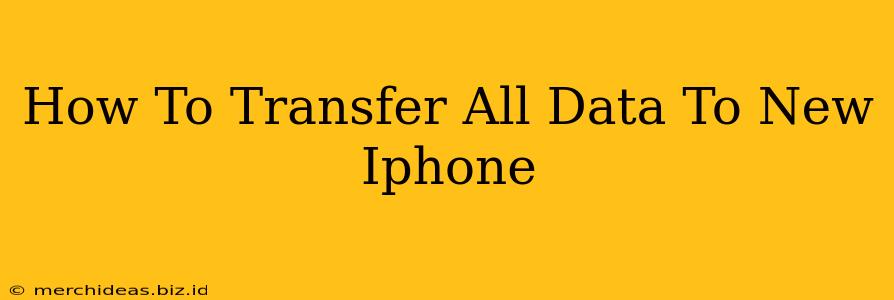Switching to a new iPhone? Don't worry about losing your precious photos, contacts, apps, and more! This comprehensive guide walks you through several ways to seamlessly transfer all your data to your shiny new device. We'll cover the easiest and most efficient methods, ensuring a smooth and stress-free transition.
Method 1: Using Quick Start (Easiest and Fastest)
This is by far the easiest and quickest way to transfer everything. Quick Start uses Bluetooth and Wi-Fi to wirelessly transfer your data. Here's how:
- Power on your new iPhone: Follow the on-screen instructions until you reach the screen that says "Apps & Data".
- Position your old and new iPhones close together: Keep them within a few inches of each other.
- Select "Transfer Data from iPhone": On your new iPhone.
- Follow the on-screen instructions: Your old iPhone will display a code. Enter this code on your new iPhone to begin the transfer process.
- Choose what to transfer: You can select to transfer all data or choose specific data types.
- Wait for the transfer to complete: This can take some time depending on the amount of data you have. Keep both phones close and connected to power.
Pros: Fast, easy, and wireless. Cons: Requires both iPhones to be relatively new and compatible with iOS 12.4 or later.
Method 2: Using iCloud Backup (Convenient for Cloud Storage Users)
If you regularly back up your iPhone to iCloud, this is a convenient method. It's especially useful if you don't have your old iPhone readily available.
- Back up your old iPhone to iCloud: Make sure your old iPhone is connected to Wi-Fi and has sufficient iCloud storage. Go to Settings > [your name] > iCloud > iCloud Backup and tap "Back Up Now."
- Set up your new iPhone: Follow the on-screen instructions until you reach the "Apps & Data" screen.
- Sign in with your Apple ID: Use the same Apple ID that you used on your old iPhone.
- Restore from iCloud Backup: Choose "Restore from iCloud Backup" and select your most recent backup.
- Wait for the transfer to complete: This process will take longer than Quick Start, depending on the size of your backup and your internet connection speed.
Pros: Convenient if you already back up to iCloud, can be done remotely. Cons: Requires a strong Wi-Fi connection and sufficient iCloud storage. The transfer time is significantly longer than Quick Start.
Method 3: Using iTunes or Finder Backup (For a Wired Connection)
This method uses a wired connection to your computer and is a good option if you have limited or unreliable Wi-Fi.
- Back up your old iPhone using iTunes or Finder: Connect your old iPhone to your computer. Open iTunes (for older macOS versions) or Finder (for newer macOS versions). Select your iPhone and click "Back Up Now."
- Set up your new iPhone: Follow the on-screen instructions until you reach the "Apps & Data" screen.
- Restore from iTunes or Finder Backup: Choose "Restore from Mac or PC backup". Select your most recent backup.
- Wait for the transfer to complete: The transfer time will vary based on the backup size.
Pros: Reliable, even with poor Wi-Fi. Good for large backups. Cons: Requires a computer and a cable.
Choosing the Right Method for You
The best method for transferring your data depends on your individual circumstances and preferences. Quick Start is the fastest and easiest if both devices are compatible. iCloud Backup is convenient for those who already use iCloud. iTunes/Finder Backup offers a reliable alternative if you have Wi-Fi issues.
No matter which method you choose, make sure your devices are fully charged before starting the transfer process. This prevents interruption and data loss. Remember to also review and update your Apple ID passwords to ensure a smooth transition! Enjoy your new iPhone!
